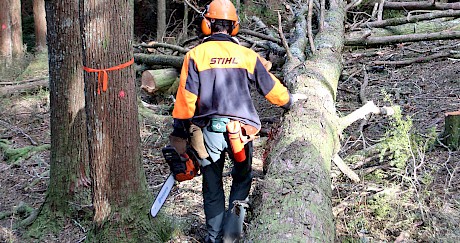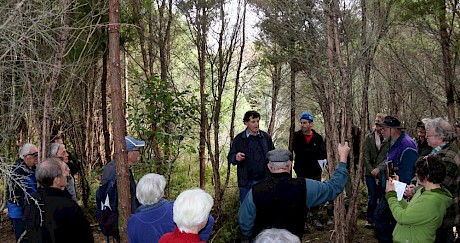Rewarewa (Knightia excelsa)
Introduction
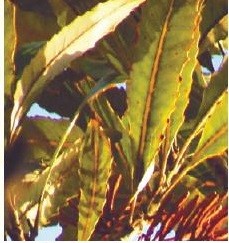 Rewarewa wood is instantly recognisable because of its pale to dark reddish colour and attractive flecked appearance, often seen in rulers made of inlaid native timber in tourist shops. It is one of only two species in the Protea family in New Zealand; species of which are common in Australia and South Africa. In spring, rewarewa flowers produce abundant nectar which is irresistible to tui and bellbirds and also produces an excellent honey.
Rewarewa wood is instantly recognisable because of its pale to dark reddish colour and attractive flecked appearance, often seen in rulers made of inlaid native timber in tourist shops. It is one of only two species in the Protea family in New Zealand; species of which are common in Australia and South Africa. In spring, rewarewa flowers produce abundant nectar which is irresistible to tui and bellbirds and also produces an excellent honey.
History
The nectar of rewarewa used to be collected and eaten by Maori who picked the flowers in late spring and tapped them onto the inside of a gourd vessel. The inner bark was bandaged over a wound to stop bleeding and speed its healing (Crowe 1999). The timber of rewarewa was not used to any extent by the Maori.
Pioneer Europeans saw the decorative properties of rewarewa wood and used it in inlay and marquetry work. However, the timber was also used in bush tramways, brake blocks, and fence battens (Hinds & Reid 1957). Its common name is New Zealand honeysuckle, which refers to the timber’s decorative properties. It was, however, also called the ‘Bucket of Water’ tree as it is useless for firewood.
Distribution
Rewarewa occurs throughout the North Island but only in the Marlborough Sounds in the South Island, occurring from the coast to about 850 m elevation. It is largely a pioneer species and, in the central North Island, dense rewarewa-kamahi stands are often associated with past burning and clearing. Rewarewa is often associated in natural forest with poor soils.
Tree size and growth
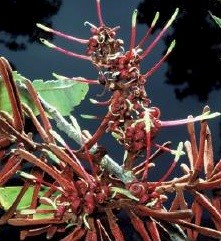 Photos: H Janssen, Bush Vitality AssessmentRewarewa are generally known for their symmetrical conical shape (similar to ricker kauri when young). They can grow up to 30 m tall with a 1 m diameter trunk. There is little data on growth rate. Height growth averages 30 to 39 cm per annum and annual diameter increment is between 0.5 and 0.8 cm.
Photos: H Janssen, Bush Vitality AssessmentRewarewa are generally known for their symmetrical conical shape (similar to ricker kauri when young). They can grow up to 30 m tall with a 1 m diameter trunk. There is little data on growth rate. Height growth averages 30 to 39 cm per annum and annual diameter increment is between 0.5 and 0.8 cm.
Timber
The dry sapwood is silvery pinkish brown and the heartwood a dark red to purple brown with very prominent medullary rays. The timber is not durable and the sapwood is prone to attack by the insects Anobium and Lyctus. Sapwood is treatable with boron salts. Timber characteristics, with P. radiata figures shown in brackets for comparison, are:
Density (at 12% M.C.) 721 kg/m³ (500 kg/m³)
Moisture content green 96% (130%)
Tangential shrinkage – green to 12% m.c. 9.5% (4.7%)
Radial shrinkage 3.8% (2.2%)
Modulus of rupture (air dry) 125 (90 Mpa)
Modulus of elasticity (air dry) 18.3 (9 Gpa)
As can be seen from these figures, rewarewa is notorious for tangential shrinkage and is difficult to kiln or air dry. It is classed as very unstable; however it is strong, having twice the elasticity of P radiata. Boards of 25 mm thickness can take up to 9 months to air-dry; however, once dry it is a tough and hard-wearing timber that machines well.
Potential and research requirements
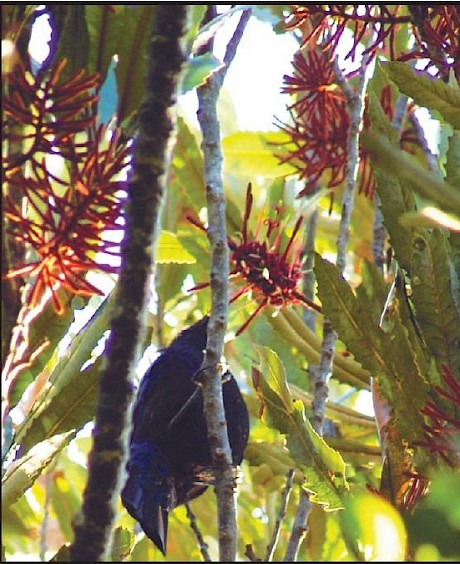 There has been very little research into rewarewa silviculture. It has the potential to be a fast-growing timber tree which, on the right site, could produce good-quality timber for specialist uses including veneer. Multi-leaders can occur in planted stands.
There has been very little research into rewarewa silviculture. It has the potential to be a fast-growing timber tree which, on the right site, could produce good-quality timber for specialist uses including veneer. Multi-leaders can occur in planted stands.
References
Clifton N C 1990. New Zealand timbers
Crowe, A. 1999: Which native tree? Penguin books.
Hinds, H.V., Reid, J.S. 1957: Forest trees and timbers of New Zealand. New Zealand Forest Service Bulletin No. 12 Government Printer, Wellington.
Pardy G F, Bergin D O & Kimberley M O 1992. Survey of Native tree plantations. FRI Bulletin 175
Salmon, J.T. 1980: The Native Trees of New Zealand. Reed.
Species profile by Ian Barton

